I was rummaging around a few posts about Ukraine-Russian airwar and the wide range of opinions on relative effectiveness. Someone had posted a graphic from this report and a reference link. I found this analysis and history to be more interesting than the propaganda spin going on in the Twittersphere.
I thought you chaps might like to read excerpts here!
CSBA report by John Stillion -https://www.files.ethz.ch/isn/190269/Air-to-Air-Report-.pdf
For about fifty years, pilots relied on the human eye as the primary air-to-air sensor and machine guns and automatic cannon as their primary weapons. The physical limitations of human vision give it a relatively short effective range as an air-to-air sensor of about 2 nautical miles (nm). Aircraft can be seen farther away if the highly sensitive central vision is focused on them, but with central vision limited to a cone roughly 2 degrees wide, pilots searching for opposing aircraft without some sort of cue to limit their search are unlikely to detect them until the less acute peripheral vision is able to resolve them at about 2 nm.
The effective range of aerial gunnery grew from about 50 meters (m) during World War I to about 500 m by the early 1960s, but pilots were still required to maneuver their aircraft in a small portion of the sky to ensure hits on an opponent. Against an un-alerted opponent, the attacker simply had to ensure he was within range and had the target “in his sight.” Against an alerted opponent, achieving hits required the attacker not only to be in range, but also to maneuver in the same plane as the target and to allow sufficient lead to account for the distance the target would travel during the bullet’s time of flight. The difficulties and time required in attaining a good firing solution against a maneuvering target, combined with the decrease in SA due to the need to fully concentrate on the target, caused many of the great aces of World War II to shun maneuvering combat as a high-risk, low-payoff activity.
Instead, they strove to achieve quick surprise attacks, break away, assess the situation, and attack again if possible.
By the mid-1960s, new aerial weapons and sensors appeared in conflicts in Southeast Asia, South Asia, and the Middle East. The new weapons included both infrared (IR) and radarguided missiles, while the new sensors were largely air-to-air radars. IR missiles allowed attacks within a 30-degree cone behind the target at ranges approaching the 2 nm effective visual search radius. Radar-guided missiles, in theory, allowed attacks from any aspect (front, side, or rear) and beyond visual range (BVR).
Air-to-air radars were capable of detecting and tracking targets at 15 nm or more. While the early missiles and radars had serious limitations and were unreliable, they offered substantial advantages over guns and the human eye. CSBA compiled a database of over 1,450 air-to-air victories from multiple conflicts from 1965 to the present.
Advances in air-to-air sensor and weapon capabilities are illustrated in Figure 1. Guns were displaced by rear-aspect-only IR missiles, which were in turn replaced by all-aspect missiles, and finally, BVR missiles have come to make up the majority of modern air-to-air engagements.

These trends suggest that over the past five decades, advances in radar and other sensor technologies, missile capabilities, and communication technologies allowed pilots to search effectively much larger volumes of sky and engage targets at ever-increasing range. Most modern air combat engagements were initiated before the aircraft were within visual range with a commensurate decrease in the frequency of maneuvering combat.
This means that aircrew SA is no longer primarily linked to what they can physically see through the cockpit canopy, but to what they glean from cockpit displays of sensor output and information passed from offboard sources such as nearby friendly aircraft. This transformation may be steadily reducing the utility of some attributes traditionally associated with fighter aircraft [Blog emphasis added] (e.g., extreme speed and maneuverability) while increasing the value of attributes not usually associated with fighter aircraft (e.g., sensor and weapon payload as well as range).
Aircraft performance attributes essential for success in air-to-air combat during the gun and early missile eras such as high speed, good acceleration, and maneuverability are much less useful now that aircraft can be detected and engaged from dozens of miles away. At the same time, non traditional attributes such as minimal radar and IR signature; space, payload, and cooling capacity; power for large-aperture long-range sensors; and very-long-range weapons seem to be of increased importance. [Blog emphasis added]
Both supersonic speed and high maneuverability place significant constraints on aircraft designers and force tradeoffs in aircraft design that limit the incorporation of many of the nontraditional, but increasingly important attributes listed above.
The trends identified in this report suggest it may be appropriate to cast a much wider net in the development of future air combat operational concepts, sensors, weapons, and platforms, which would include examining “radical” departures from traditional fighter concepts that rely on enhanced sensor performance, signature control, networks to achieve superior SA, and very-long-range weapons to complete engagements before being detected or tracked by enemy aircraft.
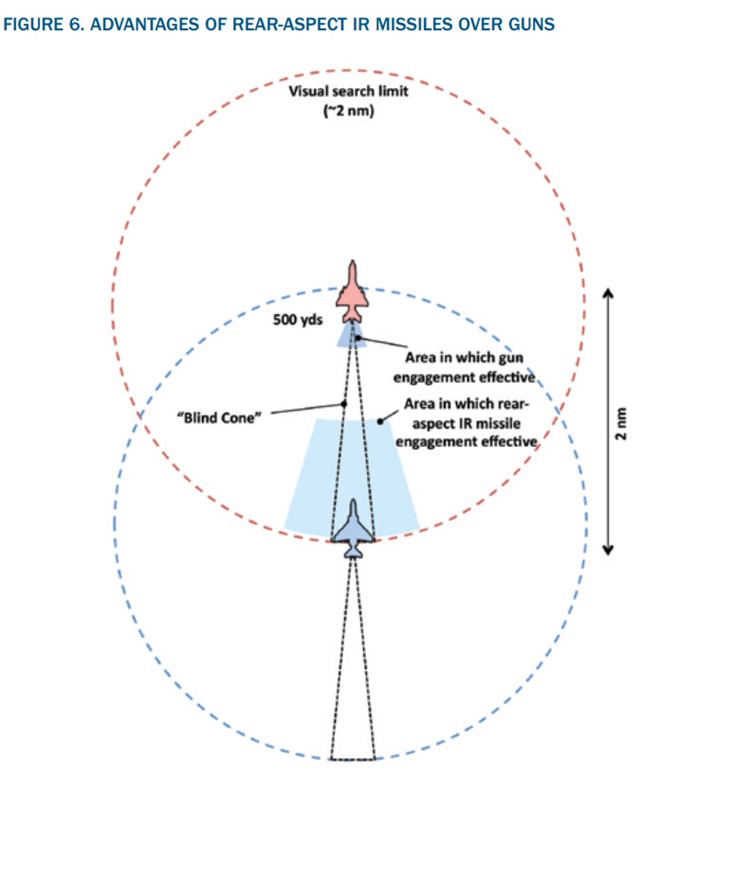
Humans are generally capable of making two to three fixations per second, but aircrew must devote significant time and attention to tasks other than visual search such as maintaining formation, speed and altitude, navigation, monitoring other sensors (e.g., radar), and monitoring aircraft fuel status and other systems, so the calculations presented here assume only about 20 percent of the pilot’s time is devoted to disciplined visual search. Ibid., 11.
Figure 6 illustrates several important aspects of air combat at the dawn of the missile era. The first is the effective uncued visual search limit, which is shown as a dashed circle centered on each aircraft. Note the dashed lines forming a wedge-shaped area directly behind the aircraft indicates an area difficult for pilots to visually scan. The extent of this blind spot varies with aircraft type. This reality is one of the main reasons that fighter aircraft fly in formations, which permit them to clear each other’s blind spots and warn of impending attacks. As the preceding discussion of visual search showed, however, even in formations where aircrew execute disciplined visual search plans, the physical limitations of human vision still make it unlikely any aircraft in the formation will see an attacker that is still more than about 2.5 nm away. The light blue wedge represents the area where the attacking aircraft could employ a typical first-generation IR homing missile. This area is about 30 degrees wide and extends from the missile’s minimum range, typically about 2,500 feet, to its maximum range of about 2.3 nm at high altitudes to less than 1 nm at low altitudes. Early IR missile seekers were generally uncooled and tuned to detect IR radiation emitted by the hot metal of jet engine turbine blades and tailpipes. This limited them to “tail-only” attacks.18
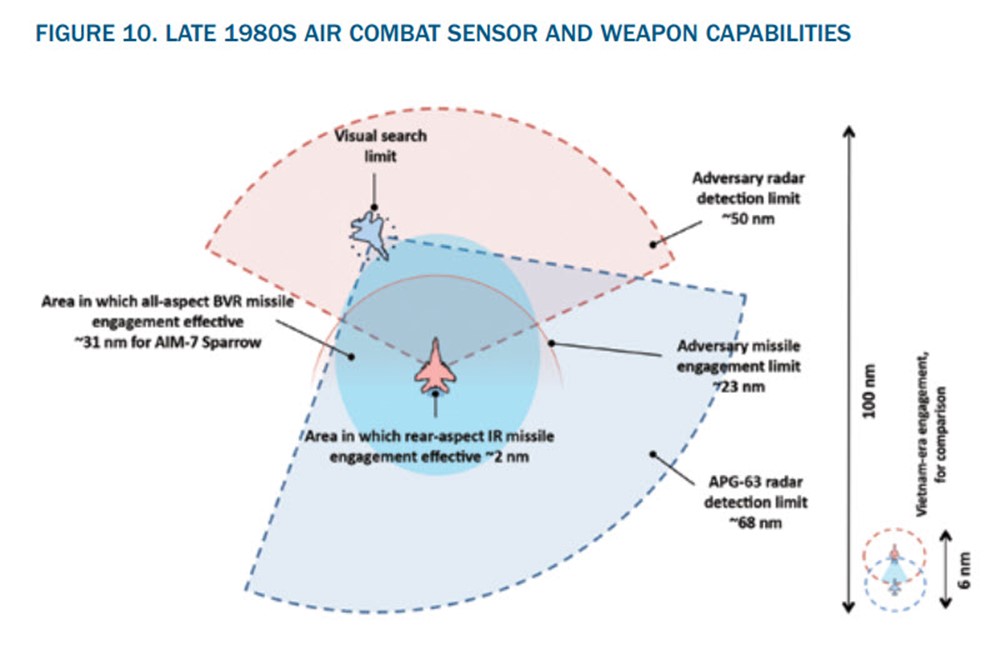
Figure 10 illustrates how sensor and weapon technologies in widespread service by the late 1980s had greatly expanded the potential engagement zone available to attacking aircraft.
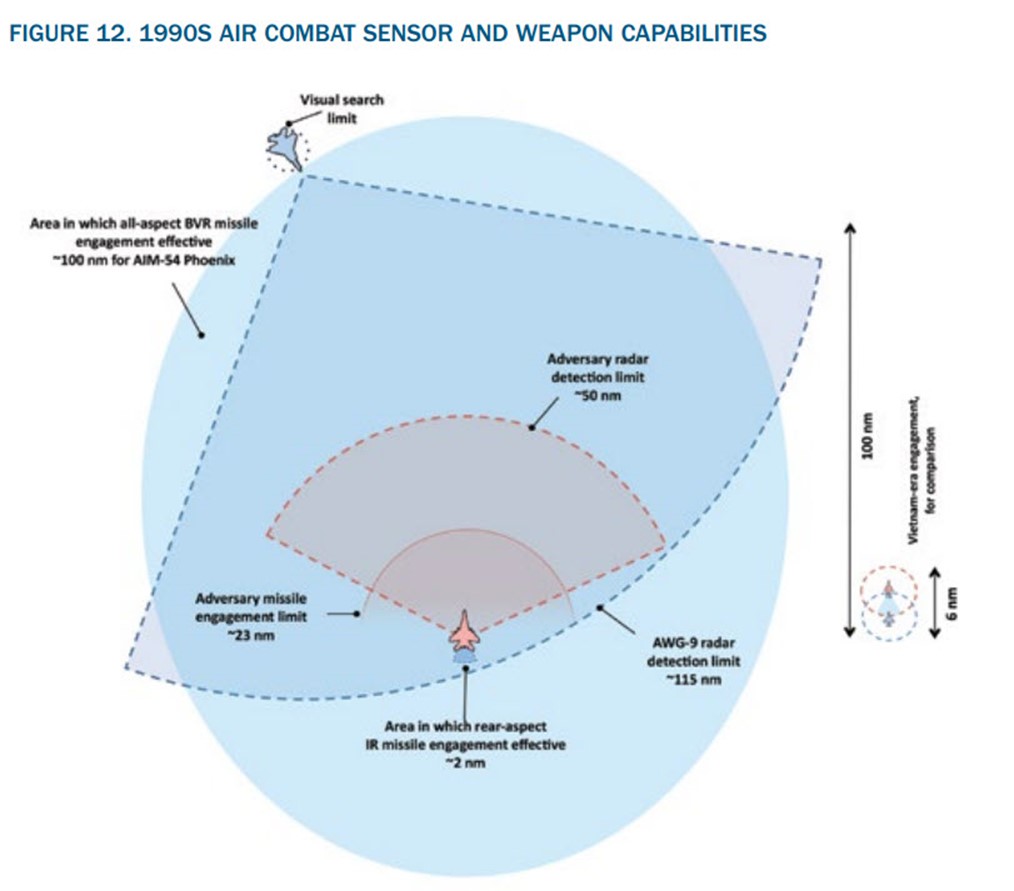
Figure 12 shows the vast increase in aerial sensor and weapon ranges available to fighter pilots of the 1990s compared to those of the 1960s
By the end of the Cold War, both NATO and Warsaw Pact air forces were equipped with air superiority fighters with pulse Doppler radar systems able to detect and target enemy aircraft at 40 nm or more, even when the target aircraft were flying in ground clutter at low altitude. This capability, often referred to as “look down/shoot down,” was a significant improvement over fighter fire control radars fielded in the 1960s and 1970s and greatly expanded the potential utility of BVR engagements by eliminating the “low-altitude sanctuary” presented by earlier fighter radars.
The use of guns in aerial combat virtually ended after the Yom Kippur War in late 1973. Out of 498 victory claims since that time, 440 (88 percent) have been credited to AAMs and only thirty to guns.39 The last gun kill of one jet combat aircraft by another occurred in May of 1988 when an Iranian F-4E downed an Iraqi Su-22M with 20 mm cannon fire.
First Gulf War:
The First Gulf War produced the largest number of aerial victory claims in a single operation since the end of the Cold War. Coalition aircrew destroyed thirty-three Iraqi fixed-wing aircraft during the war in exchange for the loss of a single F/A-18 to a BVR missile launched by an Iraqi MiG-25 on the opening night of the war. In contrast, U.S. aircrew achieved a kill ratio of only about 2:1 against the North Vietnamese Air Force. Moreover, the Iraqi Air Force in 1991 was probably better equipped relative to U.S. forces than the North Vietnamese had been twenty years before, and many Iraqi pilots had combat experience from the recently concluded Iran-Iraq War.
It is true that U.S. aircrew had much improved air combat skills derived from training innovations such as Red Flag, Top Gun, and the USAF Fighter Weapons School and Aggressor programs. As previously mentioned, however, short-range maneuvering combat was rare during Desert Storm, and most engagements began with weapons fired before sighting enemy aircraft. If we limit ourselves to examining only instances of aerial combat that took place during the first three days of Desert Storm while Iraqi aircraft were still attempting defensive operations similar to those flown by the North Vietnamese two decades before, then the coalition victory margin declines to “just” 11:1.
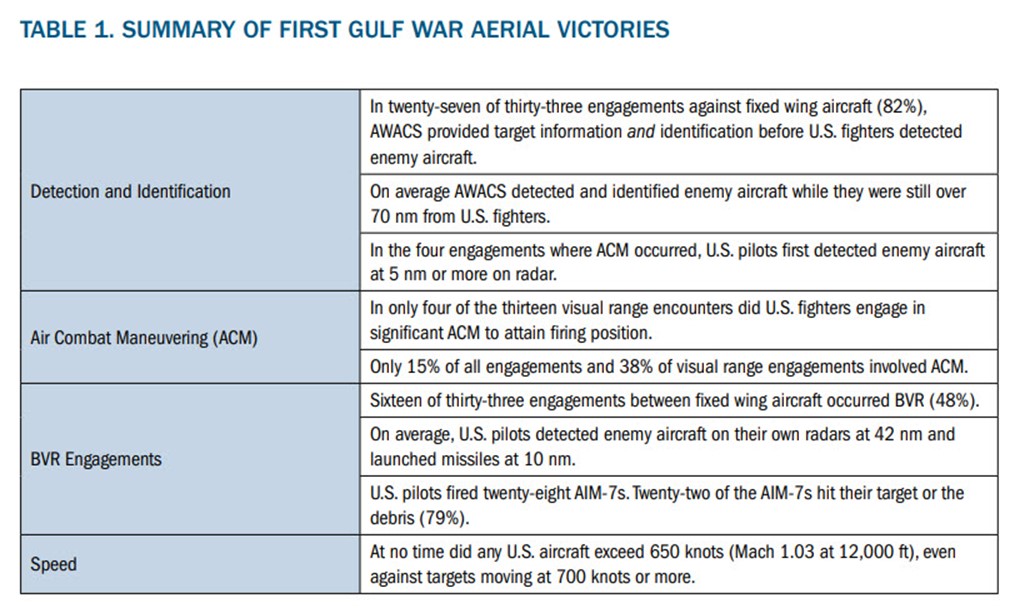
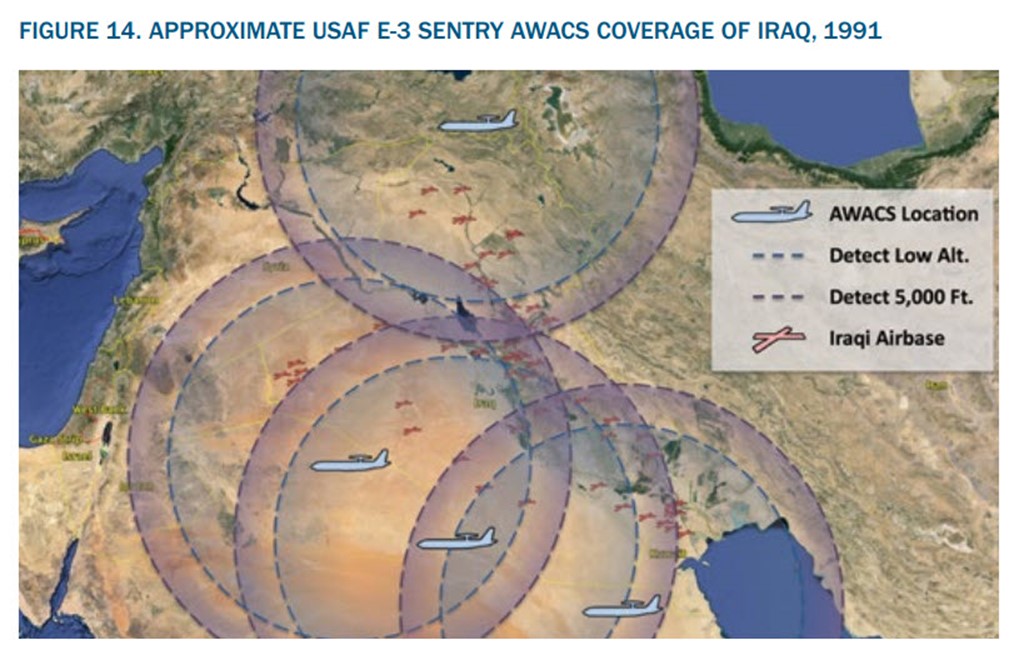
During the First Gulf War, the E-3s proved their worth many times over. Their improved sensors and higher operating altitude allowed them to detect enemy aircraft that were flying at low altitudes at about 225 nm. Aircraft operating at higher altitudes could be detected even further away. Figure 14 shows how this allowed E-3 aircraft operating continuously at three orbit locations inside Saudi Arabia and a fourth in Turkey to detect Iraqi combat aircraft during their takeoff rolls at about three-quarters of Iraq’s airbases. E-3 crews could detect and track aircraft operating at or above 5,000 feet virtually anywhere inside Iraq.
This combined with the significant increase in the lethality and reliability of U.S. AAMs between 1973 and 1991. AIM-7 Sparrows fired by USAF aircrew were over six times more reliable in 1991 than they had been during Rolling Thunder in 1965–1968 and about five times more reliable than the “improved” AIM-7s used during Linebacker I and II in 1972 and 1973. Sidewinder reliability also improved by nearly a factor of four relative to its late Vietnam ancestors.47 Overall, AAMs launched by USAF crews in the First Gulf War were about three times more likely to achieve a kill than missiles launched during the Vietnam War.
If there is interest, I’ll share more details from the paper on the impact of airframe dynamics to sensor packages and the ability to see effectively BVR. Or feel free to visit the report yourself to read as desired.